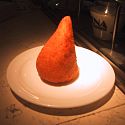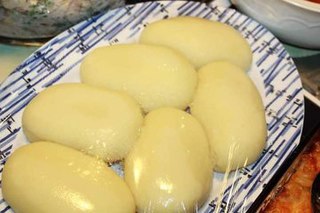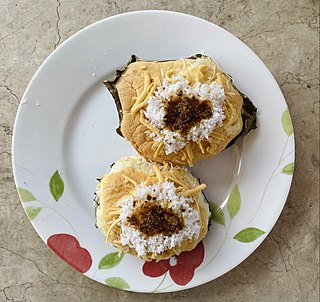
This is a list of cassava dishes that use cassava as a main ingredient. The cassava is a woody shrub native to South America of the spurge family. It is extensively cultivated as an annual crop in tropical and subtropical regions.

This is a list of cassava dishes that use cassava as a main ingredient. The cassava is a woody shrub native to South America of the spurge family. It is extensively cultivated as an annual crop in tropical and subtropical regions.
| Name | Image | Description |
|---|---|---|
| Bánh khoai mì |  | A Vietnamese snack dessert that contains grated cassava |
| Cassava cake |  | A dessert from the Philippines and an adaptation of the cooking process of the native bibingka rice cake. It was popularized in the 16th century when Spanish Galleons imported cassava from Latin American countries. It usually contains custard and milk and is usually eaten during merienda or during special occasions. |
| Coxinha |  | A popular food in many countries in South America. The drumstick is a Brazilian snack originally from São Paulo made with cassava flour dough filled with chicken or minced beef. |
| Deep-fried cassava |  | Fried cassava is a typical substitute for French fries in Brazil, Venezuela, Colombia, and several Central American countries including Panama. It is commonly served in bars along with beer. |
| Farofa |  | A toasted cassava flour mixture. In Brazil, where farofa is particularly popular, typical recipes call for raw cassava flour to be toasted with butter, salt, and bacon until golden brown, being incremented with numerous other ingredients. It is an essential accompaniment to feijoada. |
| Tapioca |  | A starch extracted from cassava (Manihot esculenta). This species is native to the Northeast of Brazil but spread throughout the South American continent. The plant was spread by Portuguese and Spanish explorers to most of the West Indies, Africa and Asia, including the Philippines and Taiwan, being now cultivated worldwide. In Brazil, the plant (cassava) is named "mandioca", while its starch is called "tapioca". |
| Sopa de Mandioca |  | Sopa de Mandioca is a very tasteful soup made from cassava. This delicious soup is consumed by many people and there are some variations in which people add some minced meat, sun dried meat, ribs or just extra condiments. |
| Cassava Pie | Cassava pie is a traditional Bermudian Christmas dish which is often considered to be a savoury cake rather than pie. Its main ingredients are grated cassava, chicken, butter and sugar. | |
| Kabkab |  | Also known as "cassava cracker" or "cassava crisp", is a traditional Filipino disc-shaped wafer made from ground cassava. It originates from the southern Philippines, but is most closely associated with the cuisine of Mindanao and the southern Visayas Islands. |
| Piutu | A traditional Filipino dish that is the staple food of the Sama-Bajau people of the Philippines and the east coast of Sabah. It is made from steamed cassava (panggi) that is mashed and shaped into cylinders. They were traditionally wrapped in banana or palm leaves, but are commonly sold wrapped in clear plastic today. It is typically torn or cut into small disks for eating. It is not flavored and thus need to be eaten with another accompanying dish, usually seafood. | |
| Putong kamotengkahoy | Also known as puto binggala in Visayan and puto a banggala in Maranao. A small cupcake made from cassava, grated coconut, and sugar. It is very similar to cassava cake, except it is steamed rather than baked. | |
| Puto lanson |  | A traditional steamed cake ( puto ) from Iloilo, Philippines, made of grated cassava topped with sweetened coconut strips ( bukayo ) |
| Kurokud | A type of cassava suman from the Philippines with a filling of sweetened grated coconut ( bukayo ) | |
| Sumang kamotengkahoy |  | A type of suman (leaf-wrapped steamed [rice] cake) from the Philippines made from cassava. Usually eaten with coconut caramel ( latik ). It is also known simply as "cassava suman". |
| Tapai |  | A traditional fermented preparation of starchy foods (traditionally rice) in Southeast Asia, used in the process of making sweet-sour edible pastes or alcoholic drinks. Widespread variants, like the Indonesian peuyeum, have used cassava as the starch source since colonial times. |

Tapioca is a starch extracted from the storage roots of the cassava plant, a species native to the North and Northeast regions of Brazil, but whose use is now spread throughout South America. It is a perennial shrub adapted to the hot conditions of tropical lowlands. Cassava copes better with poor soils than many other food plants.

Fufu is a pounded meal found in West African cuisine. It is a Twi word that originates from the Akans in Ghana. The word, however, has been expanded to include several variations of the pounded meal found in other African countries including Sierra Leone, Guinea, Liberia, Cote D'Ivoire, Burkina Faso, Benin, Togo, Nigeria, Cameroon, the Democratic Republic of Congo, the Central African Republic, the Republic of Congo, Angola and Gabon.

Bibingka commonly refers to a type of baked rice cake from the Philippines that is traditionally cooked in a terracotta oven lined with banana leaves and is usually eaten for breakfast or as merienda especially during the Christmas season.

The cuisine of the Democratic Republic of the Congo and the Republic of the Congo varies widely, representing the food of indigenous people. Cassava, fufu, rice, plantain and potatoes are generally the staple foods eaten with other side dishes.

Ghanaian cuisines refer to the meals of the Ghanaian people. The main dishes of Ghana are organized around starchy staple foods, which goes with either sauce or soup accompanied with a source of protein. The main ingredients for the vast majority of soups and stews are; tomatoes, hot peppers and onions. Most Ghanaian soups and stews are red or orange in appearance as a result of the main ingredients used.

Bammy is a traditional Jamaican cassava flatbread descended from the simple flatbread eaten by the Arawaks, Jamaica's original inhabitants. Today, it is produced in many rural communities and sold in stores and by street vendors in Jamaica and abroad.

Belizean cuisine is an amalgamation of all ethnicities in the nation of Belize and their respectively wide variety of foods. Breakfast often consists of sides of bread, flour tortillas, or fry jacks that are often homemade and eaten with various cheeses. All are often accompanied with refried beans, cheeses, and various forms of eggs, etc. Inclusive is also cereal along with milk, coffee, or tea.

A great variety of cassava-based dishes are consumed in the regions where cassava is cultivated, and the ingredient is included many national or ethnic specialities.

Daun ubi tumbuk is a vegetable dish commonly found in Indonesia, made from pounded cassava leaves. In Indonesian, daun means leaf, ubi refers to cassava, and tumbuk means pounded. The cassava leaves are traditionally pounded with a wooden mortar and pestle, although finely chopping or puréeing them using a blender or food processor is an alternative.

Chadian cuisine is the cooking traditions, practices, foods and dishes associated with the Republic of Chad. Chadians use a medium variety of grains, vegetables, fruits and meats. Commonly consumed grains include millet, sorghum, and rice as staple foods. Commonly eaten vegetables include okra and cassava. A variety of fruits are also eaten. Meats include mutton, chicken, pork, goat, fish, lamb and beef. The day's main meal is typically consumed in the evening on a large communal plate, with men and women usually eating in separate areas. This meal is typically served on the ground upon a mat, with people sitting and eating around it.

Central African cuisine includes the cuisines, cooking traditions, practices, ingredients and foods of the Central African Republic (CAR). Indigenous agriculture in the country includes millet, sorgum, banana, yam, okra, yellow onion, garlic, spinach, rice and palm oil. Imported crops of American origin include maize, manioc (cassava), peanuts, chili peppers, sweet potato and tomato. Additional foods include onions, garlic, chiles and peanuts.

Togolese cuisine is the cuisine of the Togolese Republic, a country in Western Africa. Staple foods in Togolese cuisine include maize, rice, millet, cassava, yam, plantain and beans. Maize is the most commonly consumed food in the Togolese Republic. Fish is a significant source of protein. People in Togo tend to eat at home, but there are also restaurants and food stalls.

The cuisine of Solomon Islands has developed over 5,000 years of inhabitation and external influences. From the Spanish, the islands received cattle; from the Asians and Indians, spices, exotic vegetables and fruit.
Parakari is a fermented alcoholic beverage made by Amerindians of Guyana and Venezuela. Like other cassava alcoholic beverages, parakari is made by dual fermenting cassava, which involves the use of an amylolytic mold by chewing it.

Nasi kapau is a Minangkabau steamed rice topped with various choices of dishes originated from Nagari Kapau, Bukittinggi, a tourism and culinary hotspot town in West Sumatra, Indonesia. It is often describes as Minang version of nasi ramas or nasi campur.

Nasi padang, sometimes referred to as Padang rice, is a Minangkabau dish of steamed rice served with various choices of pre-cooked dishes originating from West Sumatra, Indonesia. It is named after the city of Padang, capital of the West Sumatra province. A miniature banquet of meats, fish, vegetables, and spicy sambals eaten with plain white rice, it is Sumatra's most famous export and the Minangkabau people's primary contribution to Indonesian cuisine.

Gambian cuisine is part of West African cuisine and includes the culinary practices and traditions of the nation of The Gambia. Common ingredients include fish, rice, peanuts, tomato, black-eyed peas, lemon, cassava, cabbage, salt, pepper, onion, chili, and various herbs. Oysters are also a popular food from the River Gambia, and are harvested by women.
Barbadian cuisine, also called Bajan cuisine, is a mixture of African, Portuguese, Indian, Irish, Creole, Indigenous and British background. A typical meal consists of a main dish of meat or fish, normally marinated with a mixture of herbs and spices, hot side dishes, and one or more salads. The meal is usually served with one or more sauces.
French Guianan cuisine or Guianan cuisine is a mixture of Creole, Bushinengue, and indigenous cuisines, supplemented by influences from the cuisines of more recent immigrant groups. Common ingredients include cassava, smoked fish, and smoked chicken. Creole restaurants may be found alongside Chinese restaurants in major cities such as Cayenne, Kourou and Saint-Laurent-du-Maroni.

Piutu, also known as piyutu or putu, is a traditional Filipino dish that is the staple food of the Sama-Bajau people of the Philippines and the east coast of Sabah. It is made from steamed cassava (panggi) that is mashed and shaped into cylinders or disks. They were traditionally wrapped in banana or palm leaves, but are commonly sold wrapped in clear plastic today. It is typically torn or cut into small disks for eating. It is not flavored and thus need to be eaten with another accompanying dish, usually seafood. The most popular accompaniments include latô salads, kima, and siagol. It serves as a replacement for rice, after the introduction of cassava to the Philippines from South America by the Spanish during the colonial period.